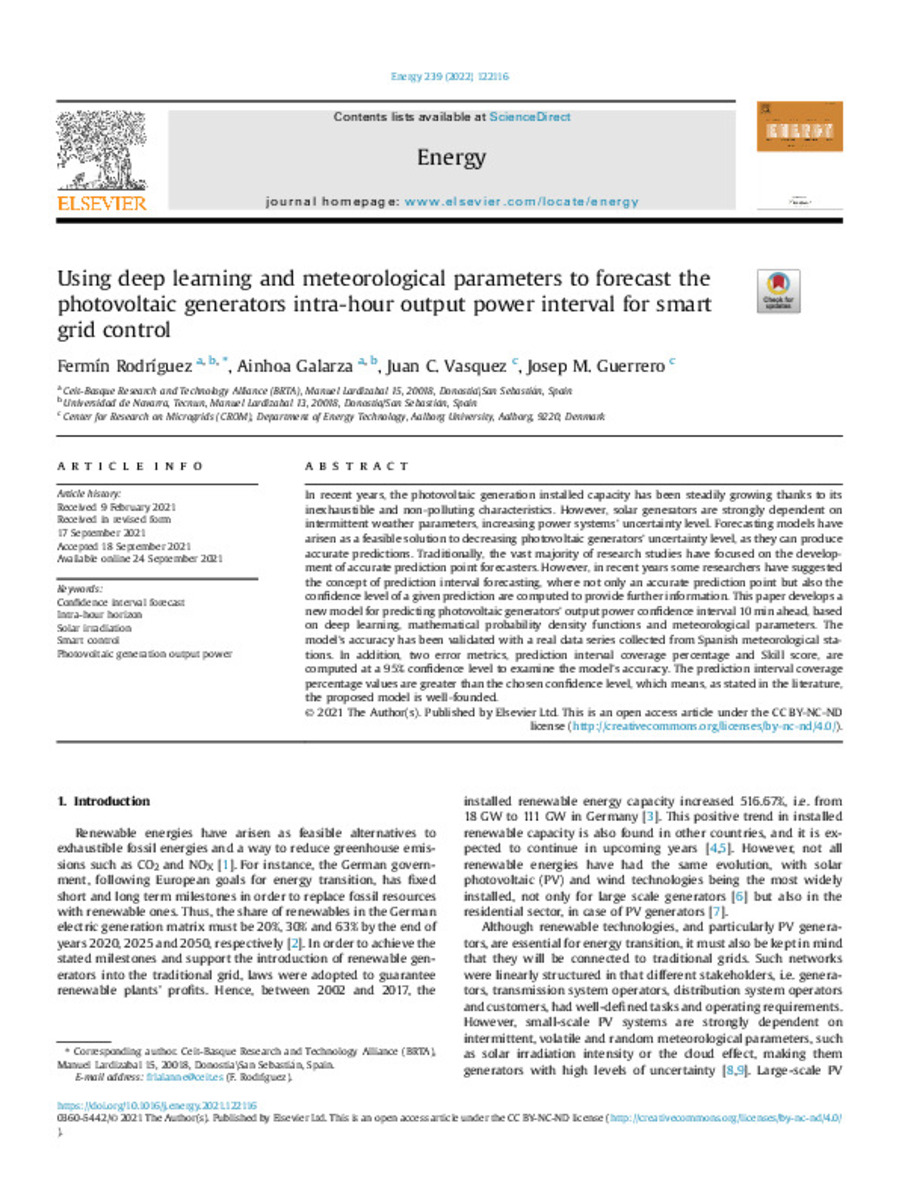Registro completo de metadatos
| Campo DC | Valor | Lengua/Idioma |
|---|---|---|
| dc.creator | Rodríguez, F. (Fermín) | - |
| dc.creator | Galarza-Rodríguez, A. (Ainhoa) | - |
| dc.creator | Vasquez, J.C. (Juan C) | - |
| dc.creator | Guerrero, J.M. (Josep M.) | - |
| dc.date.accessioned | 2022-04-13T09:36:43Z | - |
| dc.date.available | 2022-04-13T09:36:43Z | - |
| dc.date.issued | 2022 | - |
| dc.identifier.citation | Rodríguez, F. (Fermín); Galarza-Rodríguez, A. (Ainhoa); Vasquez, J.C. (Juan C); et al. "Using deep learning and meteorological parameters to forecast the photovoltaic generators intra-hour output power interval for smart grid control". Energy. (239), 2022, 122116 | es |
| dc.identifier.issn | 0360-5442 | - |
| dc.identifier.uri | https://hdl.handle.net/10171/63387 | - |
| dc.description.abstract | In recent years, the photovoltaic generation installed capacity has been steadily growing thanks to its inexhaustible and non-polluting characteristics. However, solar generators are strongly dependent on intermittent weather parameters, increasing power systems' uncertainty level. Forecasting models have arisen as a feasible solution to decreasing photovoltaic generators' uncertainty level, as they can produce accurate predictions. Traditionally, the vast majority of research studies have focused on the develop- ment of accurate prediction point forecasters. However, in recent years some researchers have suggested the concept of prediction interval forecasting, where not only an accurate prediction point but also the confidence level of a given prediction are computed to provide further information. This paper develops a new model for predicting photovoltaic generators' output power confidence interval 10 min ahead, based on deep learning, mathematical probability density functions and meteorological parameters. The model's accuracy has been validated with a real data series collected from Spanish meteorological sta- tions. In addition, two error metrics, prediction interval coverage percentage and Skill score, are computed at a 95% confidence level to examine the model's accuracy. The prediction interval coverage percentage values are greater than the chosen confidence level, which means, as stated in the literature, the proposed model is well-founded. | es_ES |
| dc.description.sponsorship | The authors would like to thank Fundaci on Caja Navarra, Obra Social La Caixa and University of Navarra for financial support through the Mobility Research Formation Programme; grant number MOVIL-2019-25 | es_ES |
| dc.language.iso | eng | es_ES |
| dc.publisher | Elsevier | es_ES |
| dc.rights | info:eu-repo/semantics/openAccess | es_ES |
| dc.subject | Confidence interval forecast | es_ES |
| dc.subject | Intra-hour horizon | es_ES |
| dc.subject | Solar irradiation | es_ES |
| dc.subject | Smart control | es_ES |
| dc.subject | Photovoltaic generation output power | es_ES |
| dc.title | Using deep learning and meteorological parameters to forecast the photovoltaic generators intra-hour output power interval for smart grid control | es_ES |
| dc.type | info:eu-repo/semantics/article | es_ES |
| dc.description.note | This is an open access article under the CC BY-NC-ND | es_ES |
| dc.identifier.doi | 10.1016/j.energy.2021.122116 | - |
| dadun.citation.number | 239 | es_ES |
| dadun.citation.publicationName | Energy | es_ES |
| dadun.citation.startingPage | 122116 | es_ES |
Ficheros en este ítem:
Estadísticas e impacto
Los ítems de Dadun están protegidos por copyright, con todos los derechos reservados, a menos que se indique lo contrario.






